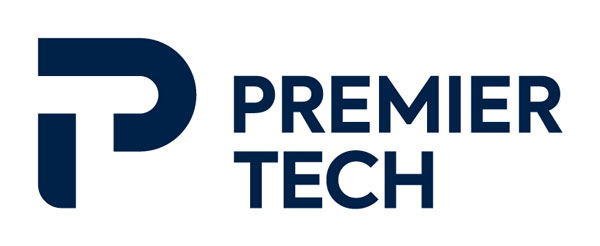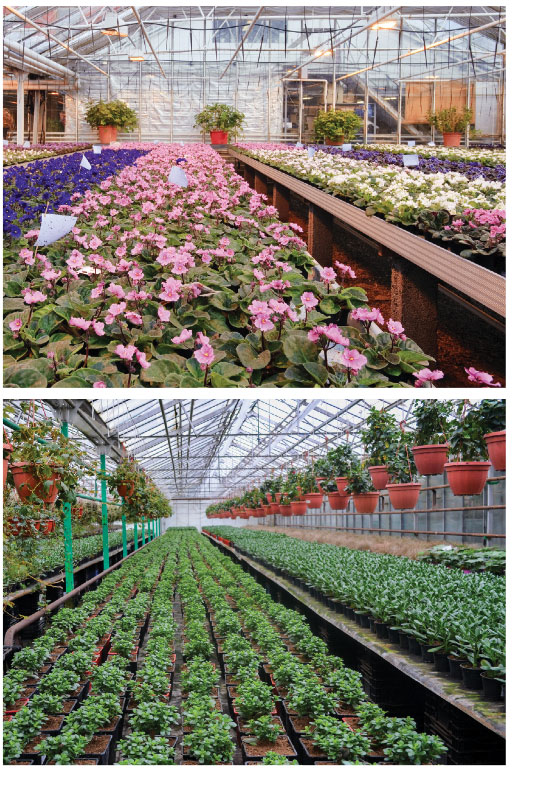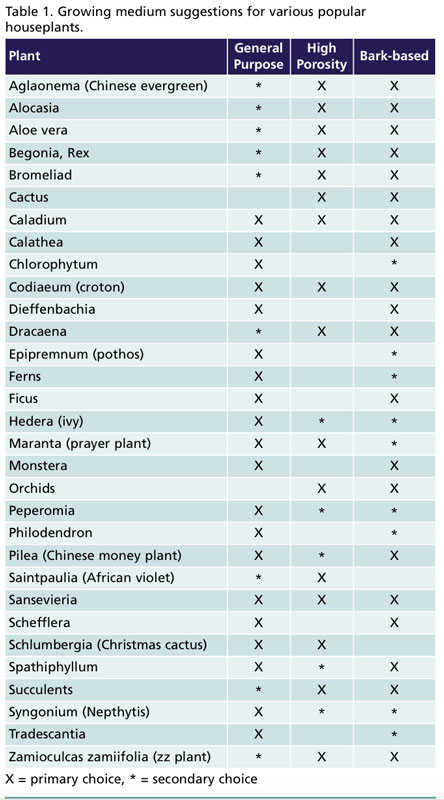5/1/2020
Helping with Homeowner Success
Troy Buechel

Houseplants continue to grow in popularity, especially for those who don’t have a yard and want to bring the outdoors inside. However, some homeowners who purchase houseplants may not have a background in growing plants, so these plants must be easy to care for to withstand poor watering and fertilization practices. This is where selecting a growing medium may be influenced less by the crop grown and more by what the plant will be subjected to by the homeowner.
There are many types of houseplants available, ranging from succulents and cactuses that like a fast-drying growing medium, to certain tropical plants that prefer moist growing media. Some houseplants grow slowly, so it’s even more important that these plants have a growing medium that dries out rapidly and are grown in containers that aren’t oversized for the plant. Other houseplants, such as epipremnum and philodendron, grow rapidly and prefer a growing medium that has more water retention, which also benefits the homeowner.

Pictured: African violets prefer a growing medium with moderate water retention and good air porosity. High-porosity growing media work best for them, as they work for the homeowner who may overwater their plants.
Jade and other succulent plants are generally grown in a growing medium that has lower water retention, such as a high porosity or bark-based growing medium. Most growers also use general-purpose, peat-based growing media, but when the homeowner receives the plant, they may overwater it, making high porosity and bark-based growing media better choices for homeowners.
First, let’s identify the different categories of growing media and why they’re used:
• General purpose, peat-based growing media are formulated with a high percentage of Canadian Sphagnum peat moss along with perlite, vermiculite, coir or wood fiber. As the name suggests, they’re a good fit for many houseplants, especially for those in 6-in. containers or smaller and hanging baskets. With higher water-holding capacity and good air porosity, they work best for fast-growing plants and those grown in full sun.
• High-porosity growing media are products also formulated with Canadian Sphagnum peat moss, but contain higher percentages of perlite (25% to 40%) and/or bark (30% or more). They have higher air porosity, so when saturated there’s plenty of oxygen to promote active root growth and slightly less water-holding capacity than general-purpose growing media.
Use for plants that are susceptible to root diseases and those grown from late fall to early spring when crops dry out slowly. High-porosity growing media are ideal for cutting propagation of most houseplants.
• Peat-bark growing media are formulated with Canadian Sphagnum peat moss, pine or fir bark ranging from 15% to 60% of the volume of the growing medium, and perlite or vermiculite. These products tend to have lower water-holding capacity and moderate to high air porosities, depending on the bark percentage.
Bark media with less than 30% bark (1/2-in. chip size or smaller) are ideal for 6-in. pots or smaller, and have similar water holding to high porosity growing media, but air space similar to general-purpose growing media. Those with 40% or more bark (1-in. chip size or smaller) are used for gallon-size pots or larger. The high percentage of bark gives them low water-holding capacity (assuming there are few bark fines less than 1/8 in.), rapid dry down and high air space, which reduces the chances of overwatering. Bark also provides the added benefit of weight, which helps to stabilize tall tropical plants that would otherwise tip over easily in lightweight growing media.

Table 1 shows the suggested growing medium category for many of the popular houseplants grown today. Some growers may prefer sand-based growing media for cactuses and succulents, but these aren’t often provided by growing media manufacturers due to weight and cost of shipping. However, these crops can do quite well in the suggested products.
Keep in mind that success in growing any houseplant commercially is often dictated by the watering techniques. Growers that irrigate frequently to maintain wet plants would benefit from growing media with low water-holding capacity, whereas growers that grow plants on the dry side and irrigate less frequently may prefer higher water retention.
Chemical properties
Most growing media come with ideal chemical properties for houseplant production, as their requirements are similar to annuals and perennials. The starting pH of most growing medium is within 5.2 to 6.2, which is similar to the 5.5 to 6.3 requirement of most houseplants. Acid-loving plants, such as azaleas, prefer a pH of 5.0 to 5.5, so a low-lime growing medium would be preferred. However, few houseplants would grow well if the growing medium pH is above 6.5. The starting EC of most growing media is between 0.5 to 2.0 mmhos.cm (S.M.E. analysis), which is ideal for most houseplants.
Biological growth enhancers
Some homeowners may struggle to properly care for their houseplants. Over or underwatering, forgetting to fertilize, poor lighting, etc. all contribute to plant stress and poor performance. This is where biological growth enhancers can help. The most common, endomycorrhizae, will colonize the roots of most houseplants. These natural soil-dwelling fungi colonize roots to help enhance uptake of water and nutrients from the growing medium where the plant roots don’t have access. This helps the plant tolerate the stress caused by lack of fertilizer and improper watering. Some endomycorrhizal fungi also help the plant tolerate high salts from excess fertilizer and regulate water uptake when overwatered.
Additionally, biological growth enhancers will continue to colonize plants roots long after the homeowner takes the plant home. So the initial investment of buying a premade growing medium with endomycorrhizal fungi or other biological growth enhancers will continue to pay dividends for the homeowner.
Biofungicides
Some plants are more susceptible to root diseases than others. Often this depends on the watering technique and certainly is more problematic during the cloudy, short days of late fall through early spring. Most houseplants would benefit from using a growing medium amended with a biofungicide that can grow on plant roots to help suppress root rot pathogens, such as Pythium, Fusarium, Rhizoctonia, etc.
Another benefit of biofungicides is that they continue to live on the plant roots and provide root disease protection long after the homeowner purchases the plant. This will improve homeowner success and may encourage them to purchase more plants.
Selecting the proper growing medium to grow houseplants in a commercial greenhouse depends on the plant species, the growing conditions, the time of year and the grower’s watering techniques. Also keep in mind how the homeowner will care for their plants—the ideal growing medium to produce crops in a greenhouse may not be ideal for homeowner requirements. Lastly, consider using a growing medium with biological additives that can help reduce plant loss, improving homeowner success. A happy customer is always a repeat
customer. GT
Troy Buechel is a Horticulture Specialist—Mid-Atlantic U.S. for Premier Tech.